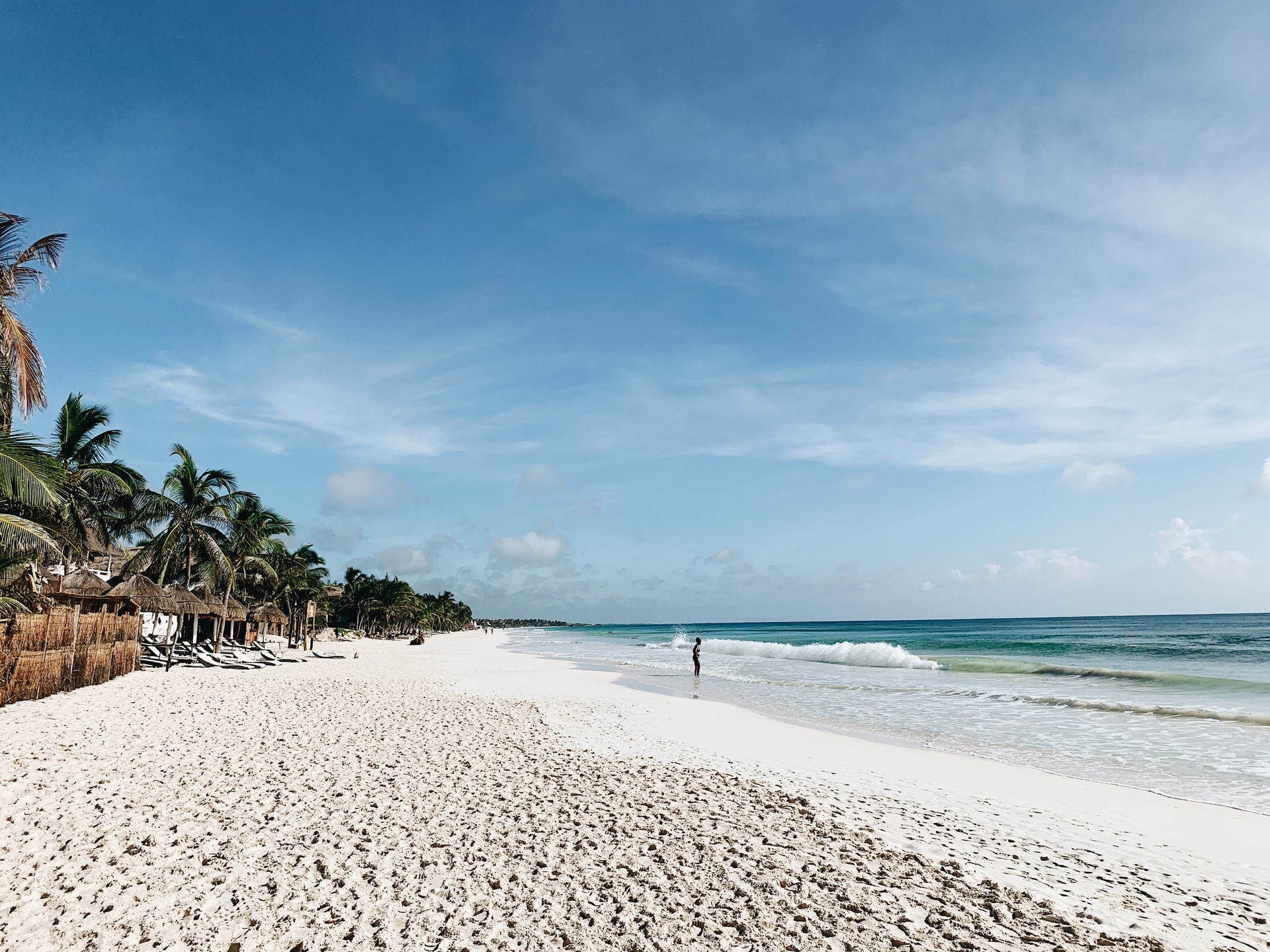Many millions of tourists visit Mexico every year. They come to find beautiful Pacific and Caribbean beaches, to enjoy delicious food and drinks, to learn about history and take in the culture, and simply to escape the everyday.
Generally speaking, peak tourist season for Mexico runs from December to April. These dates coincide with the country’s dry season and because Americans tend to flock to Mexico when they have time off from school or work—think Thanksgiving, Christmas, New Year’s, and Easter. Mexico’s resort destinations also tend to be crowded during holidays like Cinco de Mayo, Semana Santa (the week surrounding Easter), and spring break.
Mexico’s shoulder season (just before or after the peak season) can be a great time to visit, as the crowds are fewer, but the weather is still enjoyable.
However, it’s important to note that Mexico is a big country and, just like the United States, has a varied topography and distinct climates. The country has more than 5,800 miles of beaches, but also desert, jungle, mountains, and more. Always plan your trip keeping in mind the climate of the specific destination you’ll be visiting.
Here’s a quick guide on when to travel to Mexico.
Best time to visit the Baja Peninsula
Mexico’s Baja Peninsula has an extremely dry climate and summers can get seriously hot. That’s why many travelers head to Baja towns like San Jose del Cabo and Cabo San Lucas (together they’re commonly called Los Cabos) in the winter months. Not only is this region a convenient flight away from the winter weather of many US cities, but the late winter and early spring are peak times for whale watching.
From mid-December to April, humpback whales head from Alaska to Mexico to breed, and visitors in December and January are virtually guaranteed to see whales around the Baja California Peninsula.
Best time to visit Puerto Vallarta
Known as one of the safest parts of Mexico, Puerto Vallarta is a popular vacation destination for American travelers, no matter the time of year. This Pacific resort destination is busiest during the winter, thanks to temperatures in the mid-70s and very little rain. You’ll find fewer crowds, more affordable accommodations, and warmer water for ocean activities in the shoulder seasons of April to June and October to December.
Hurricane season occurs in summer and fall, but since it’s located on a bay, Puerto Vallarta is usually safe from hurricanes. The last time a hurricane ran directly through town was in 2002. If you like things hot (and you appreciate good deals), head to Puerto Vallarta during the summer. Average daily highs are in the 90s and humidity is high, but you just might have the whole place to yourself.
Best time to visit Mexico City
Many first-time visitors to Mexico City don’t know that the city sits at a dramatically high altitude; 7,382 feet above sea level, to be exact. That means that Mexico’s capital city is rarely as warm as its coastal counterparts. The best times to visit Mexico City are between March and May, when you can avoid the winter chill and the summer rain. September is the rainiest month, with average precipitation totaling 3.5 inches.
Best time to visit Cancun & the Caribbean beaches
Mexico’s Caribbean coast is another sought-after destination for travelers from the United States. After all, you can’t beat white-sand beaches and warm Caribbean waters. Known as the Riviera Maya, the region that stretches from Cancun to Tulum (and includes the island of Cozumel) is known for its picture-perfect beaches and beautiful year-round weather. Plus, you’re just a short drive from some of Mexico’s most impressive archeological sites, Chichen Itza and Tulum.
So when is the best time to visit? The peak time to visit the beaches of Quintana Roo (the state where Cancun is located) is December to April. While the crowds are heavy, you’ll enjoy idyllic weather and avoid the threat of hurricanes. Hurricane season runs from June to October, with the bulk of storms happening from late spring to late autumn. While many travelers still vacation on the Yucatan Peninsula during hurricane season, it’s wise to get a travel insurance policy—hurricanes can really wreak havoc on your vacation plans!

REGIONAL CLIMATE VARIATIONS
Mexico boasts a remarkably diverse range of climates and landscapes, which can significantly impact the best times to visit various parts of the country. Whether you’re exploring the arid deserts of the north or the lush, tropical jungles in the south, it’s essential to consider the unique weather patterns of each region to maximize your travel experience. This diversity not only highlights Mexico’s vast geographic range but also enriches the cultural and natural attractions available to travelers.
Northern Mexico
In northern Mexico, including border towns like Tijuana and desert areas like Chihuahua, the climate tends to be arid with extreme variations in temperature. Winters can be surprisingly chilly, especially at night, while summers are intensely hot. The best time to visit these areas is during the milder spring or autumn months when the weather is more temperate, making outdoor activities and exploration far more comfortable.
Central Mexico
Central Mexico, home to highland regions such as Guadalajara and San Miguel de Allende, offers a more temperate climate year-round. These areas are at high altitudes, which keeps the temperatures cooler compared to the coast. The dry season, running from November to April, provides clear skies and pleasant weather, ideal for enjoying the vibrant street life and colonial architecture. The rainy season begins around May and lasts until October, but showers are usually brief, so they don’t disrupt travel plans significantly.
SEASONAL FESTIVALS AND EVENTS
Winter Festivals
The winter months in Mexico are vibrant with cultural celebrations. Dia de los Reyes (Three Kings’ Day) in January is particularly special, with colorful parades and the tradition of the rosca de reyes cake. Carnaval, celebrated in places like Veracruz and Mazatlán, is another highlight, featuring elaborate costumes, lively dances, and grand parades.
Spring and Summer Events
Spring and summer in Mexico are vibrant with cultural celebrations, starting with the Semana Santa (Holy Week), which is a significant religious and cultural event observed throughout the country. During this week, streets come alive with processions, passion plays, and elaborate rituals commemorating the final days of Jesus Christ.
The Guelaguetza festival in Oaxaca, usually held in July, is another highlight of the season, showcasing the rich indigenous culture, traditional dances, and regional attire of the state. Additionally, Independence Day celebrations in mid-September are marked by fireworks, parades, and patriotic displays, offering a deep dive into Mexico’s spirited culture and history.
Autumn Festivals
Autumn is a significant time in Mexico, marked by Dia de los Muertos (Day of the Dead) at the beginning of November. This profound celebration honors deceased loved ones with altars, offerings, and vibrant street festivals. The festival’s rich tapestry of traditions and symbols inspired the famous, award-winning Disney movie Coco, which beautifully captures the essence and vibrancy of this holiday.
OUTDOOR ACTIVITIES BY SEASON
During the winter, visitors can engage in whale watching in Baja California, where the migration of majestic whales offers a breathtaking natural spectacle. Additionally, the surf town of Sayulita attracts wave enthusiasts with its ideal conditions for surfing during the cooler months. As spring arrives, the weather is perfect for outdoor adventures such as hiking in the expansive and scenic Copper Canyon, and exploring the ancient archaeological sites scattered across Mexico, which are more comfortable to visit in the cooler spring climate.
Summer brings the heat, making it the best time for water-related activities; divers flock to Cozumel to explore its vibrant coral reefs, while snorkelers enjoy the unique, refreshing cenotes in the Yucatan Peninsula. Autumn offers a cooler yet still sunny climate, ideal for visiting Michoacán’s butterfly sanctuaries to witness the end of the monarch butterflies’ migration, or exploring Mexico’s rich colonial cities that are steeped in history and cultural celebrations.
BEST TIME TO VISIT SPECIFIC DESTINATIONS
Oaxaca
Oaxaca is a cultural hub best visited during late October and early November for Dia de los Muertos celebrations or during the Guelaguetza festival in July, which showcases the region’s indigenous cultures. The temperate climate also makes it ideal for culinary tours year-round, offering a taste of its renowned gastronomic heritage.
Chiapas
The lush jungles and stunning Mayan ruins of Chiapas are best explored during the dry season from November to April when the weather is cooler and less humid, making the dense jungles more accessible and enjoyable for visitors.
Veracruz
For those interested in coastal activities and exploring historical sites, the best times to visit Veracruz are during the spring and early summer before the rainy season starts. The weather is warm but not yet hot, perfect for enjoying the beaches and the rich history of the region.
BUDGET TRAVEL TIPS
Traveling during the shoulder seasons (late spring and early autumn) or the low season can significantly reduce costs. These periods see fewer tourists, which means better deals on accommodations and activities, as well as a more relaxed atmosphere without the crowds.
Additionally, consider booking during the off-peak months to get the best rates on hotels and resorts. Many properties offer lower prices to attract visitors outside the high season, providing an opportunity to enjoy luxury stays at more affordable rates.
For affordable flights to Mexico, flexibility is key. Monitor flight prices and be ready to book when you spot a good deal. Flying mid-week or during less popular hours can also lead to significant savings. Signing up for airline newsletters and fare alert services can give you an advantage in catching the best prices as they appear.
TRAVEL TIPS FOR FAMILIES
When traveling with family, choosing the right destination can make all the difference. Regions like Riviera Maya and Cancun are known for their family-friendly resorts that offer activities suitable for all ages, from toddlers to teens. These resorts often feature kids’ clubs, family pools, and events designed to entertain while ensuring safety.
Planning your trip during school holidays can be a smart move to align with your children’s vacation time, but it’s wise to book early and consider the shoulder seasons to avoid the peak tourist crowds. Mexico is rich in kid-friendly activities; children can enjoy interactive experiences like swimming with dolphins in Cabo San Lucas, exploring the interactive museums of Mexico City, or even engaging in junior archaeological digs near the Mayan ruins.
CULTURAL CONSIDERATIONS AND LOCAL ETIQUETTE
Understanding and respecting local holidays and customs is crucial when visiting Mexico. Participating in cultural events can provide a deeper insight into the vibrant local traditions and enhance your travel experience. Learning a few basic Spanish phrases not only helps in navigating through various situations but also shows respect towards the locals. Phrases like “Por favor” (please), “Gracias” (thank you), and “Dónde está el baño?” (Where is the bathroom?) can be incredibly helpful.
Safety is also paramount; it’s important to follow local advice, avoid less-traveled areas at night, and respect local norms to ensure a secure and enjoyable visit.
HEALTH AND SAFETY TIPS
When traveling in Mexico, it’s crucial to avoid common travel illnesses by adhering to food and water safety practices. Always opt for bottled or purified water and ensure that your food is cooked thoroughly and served hot. Carrying hand sanitizer and washing your hands frequently can also help prevent sickness. Staying hydrated is particularly important in Mexico’s warmer climates, so make sure to drink plenty of water throughout the day.
Navigating the Altitude
For those visiting high-altitude destinations like Mexico City, which sits over 7,000 feet above sea level, acclimating to the altitude is essential. Start by taking it easy for the first few days to allow your body to adjust. Drink more water than usual, avoid heavy meals and alcohol initially, and consider medication for altitude sickness if you typically experience symptoms.
Emergency Contacts
Before you travel, it’s important to gather information on local healthcare facilities and keep a list of emergency contacts, including local emergency services and possibly your home country’s embassy. Knowing the location of the nearest hospital or clinic and how to call for emergency services can be crucial in urgent situations.
ECO-FRIENDLY TRAVEL TIPS
Minimizing your environmental impact while traveling in Mexico can be achieved through several practical steps. Use public transport, bikes, or walk as much as possible. Reduce plastic usage by carrying a reusable water bottle, especially since many hotels and hostels offer purified drinking water. Also, try to support small local businesses that practice sustainability.
Mexico boasts numerous eco-friendly resorts and nature reserves that focus on conservation and sustainable tourism. Destinations like the Sian Ka’an Biosphere Reserve in Quintana Roo or the monarch butterfly sanctuaries in Michoacán offer incredible natural beauty and biodiversity while also practicing environmental preservation. Choosing accommodations that are committed to reducing environmental impact can enhance your travel experience and support conservation efforts.
PROTECT YOUR TRIP WITH TRAVEL INSURANCE
No matter what time of year you choose to visit or which part of Mexico beckons, it’s important to have travel insurance to protect you in case the unexpected happens—whether that’s a hurricane, lost luggage, or a medical emergency. With the right travel insurance, you can ensure that unexpected events won’t derail your plans, allowing you to enjoy your trip with greater confidence and security.
So pack your bags, brush up on your Spanish, and get ready to explore the diverse beauty of Mexico. Here’s to a trip filled with adventure, relaxation, and a treasure trove of memories!

How safe is Mexico City?
As the largest city in North America, Mexico City is bursting with unforgettable travel experiences, from an incredible array of world-class museums and cultural experiences

What’s the climate in Canada like?
Canada is a vast country which rightly has a reputation for cold and snowy weather. Its northern latitude positioning and the presence of the massive
